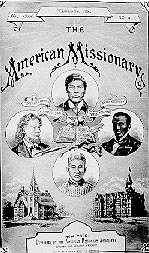American Missionary Association
The American Missionary Association (AMA) was a Protestant-based abolitionist group founded on September 3, 1846 in Albany, New York. The main purpose of this organization was to abolish slavery, to educate African Americans, to promote racial equality, and to promote Christian values. Its members and leaders were of both races and chiefly affiliated with Congregationalist, Methodist and Presbyterian churches.
History
The American Missionary Association was started by members of the American Home Missionary Society (AHMS) and the American Board of Commissioners for Foreign Missions (ABCFM), who were disappointed that their first organizations refused to take stands against slavery and accepted contributions from slaveholders. From the beginning the leadership was integrated: the first board was made up of 12 men, four of them black.[1] One of its primary objectives was to abolish slavery. The AMA (American Missionary Association) was actually one of the organizations responsible for pushing slavery onto the national political agenda.[citation needed]
The organization started the American Missionary magazine, published from 1846 through 1934. (Cornell University Library has editions accessible online in its Making of America digital library.[2]) Among its acheivements was the founding of anti-slavery churches. For instance, the abolitionist Owen Lovejoy was among the Congregational ministers of the AMA who helped start 115 anti-slavery churches in Illinois before the American Civil War, aided by the strong westward migration.[3][4]
Members of the AMA began their support of education for blacks before the Civil War, and they recruited teachers for the numerous contraband camps that developed in the South during the war. By war's end, there were 100 contraband camps, and many had AMA teachers. The AMA also served the Roanoke Island Freedmen's Colony (1863–1867). Located on an island occupied by Union troops, the colony was intended to be self-sustaining. It was supervised by Horace James, a Congregational chaplain appointed by the Army as "Superintendent for Negro Affairs in the North Carolina District". The first of 27 teachers who volunteered through the AMA was his cousin, Elizabeth James.[5] By 1864 the colony had more than 2200 residents, and both children and adults filled the classrooms in the several one-room schools, as they were eager for learning. The missionary teachers also evangelized and helped provide the limited medical care of the time.[5]
Post-war
The AMA's pace of founding schools and colleges increased during and after the war. Freedmen, historically free blacks, and white sympathizers alike believed that education was a priority for the newly freed slaves. Altogether, "the AMA founded more than five hundred schools and colleges for the freedmen of the South during and after the Civil War, spending more money for that purpose than the Freedmen's Bureau of the federal government."[1]
Among the eleven colleges they founded were Berea College and Atlanta University, (1865); Fisk University, (1866); Hampton Institute (1868) and Tougaloo College, (1869); Dillard University, Talladega College, LeMoyne/LeMoyne-Owen College, Tillotson/Huston-Tillotson University, and Avery Normal Institute (1867) (now part of the College of Charleston). Together with the Freedmen's Bureau, the AMA founded Howard University in Washington, D.C. in 1867. In addition, the AMA organized the Freedmen's Aid Society, which recruited northern teachers for the schools and arranged to find housing for them in the South.
By the 1870s, the AMA national office had relocated to New York City. Its magazine, American Missionary, had a circulation of 20,000 in the 19th century, ten times that of the abolitionist William Garrison's magazine.[1] The Cornell University Library has editions from 1878-1901 accessible online in its Making of America digital library.[2]
While the AMA became notable in the United States with its work in opposition to slavery and in support of education for freedmen, it also worked in missions in numerous nations overseas. The 19th-century missionary effort was strong in India, China and east Asia.
Over time, the association became most closely aligned with the Congregational Christian Churches. Most of those congregations have become members of the United Church of Christ (UCC). The AMA maintained its distinct identity until 1999, when a restructuring of the UCC merged it into the Justice and Witness Ministries division.
The records of the American Missionary Association are housed at the Amistad Research Center, located at Tulane University in New Orleans.
See also
- Dan Beach Bradley — Siam, 1857 to 1873
- Lincoln Academy
References
- ↑ 1.0 1.1 1.2 Clara Merritt DeBoer, "Blacks and the American Missionary Association", United Church of Christ, 1973, accessed 12 Jan 2009
- ↑ 2.0 2.1 "The Missionary Magazine" (1878-1901), Making of America, Cornell University Library, accessed 3 Mar 2009
- ↑ Clifton H. Johnson, "The Amistad Incident and the Formation of the American Missionary Association", New Conversations, Vol. XI (Winter/Spring 1989), pp. 3-6
- ↑ Paul Simon, "Preface", Owen Lovejoy, His Brother's Blood: Speeches and Writings, 1838-1864, edited by William Frederick Moore and Jane Anne Moore, University of Illinois Press, 2004, accessed 27 January 2011
- ↑ 5.0 5.1 "The Roanoke Island Freedmen's Colony", provided by National Park Service, at North Carolina Digital History: LEARN NC, accessed 11 November 2010
External links
- "Constitution of the American Missionary Association", The American Missionary, Roanoke Island Freedmen's Colony (1863–1867) Website
- "American Missionary Association", North by South, Kenyon University, 1998
- The American Missionary magazine, Project Gutenberg, most issues from 1888–1900
- "Guide to the Records of the American Missionary Association", Amistad Research Center
- Articles with unsourced statements from December 2014
- American Missionary Association
- United Church of Christ
- Abolitionism in the United States
- Pre-emancipation African-American history
- Social history of the United States
- Social history of the American Civil War
- Reconstruction Era
- History of education in the United States
- Religious organizations based in the United States
- Religious organizations established in 1846
- 1846 establishments in New York
